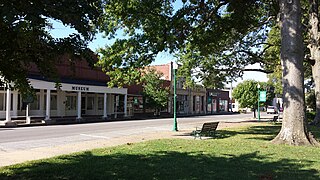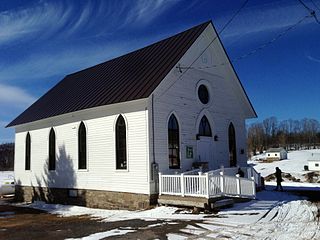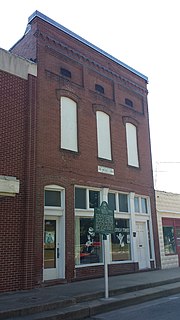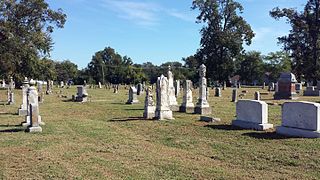
The Osceola County Courthouse is a historic courthouse in Kissimmee, Florida, located at 2 Courthouse Square. On August 16, 1977, it was added to the U.S. National Register of Historic Places.
This is an incomplete list of historic properties and districts at United States colleges and universities that are listed on the National Register of Historic Places (NRHP). This includes National Historic Landmarks (NHLs) and other National Register of Historic Places listings. It includes listings at current and former educational institutions.

This is a list of the National Register of Historic Places listings in Osceola County, Florida.

The Hale Avenue Historic District encompasses a significant portion of the central business district of Osceola, Arkansas. It extends for five blocks along Hale Avenue, between Ash and Maple Streets, and includes a few buildings on adjacent streets. The focal point of the district is the Mississippi County Courthouse, and the block of buildings opposite it on Hale Avenue. Although Osceola was founded in 1875, it was relocated beginning in 1900 to be closer to the railroad, with Hale Avenue as the major east–west route. This began a period of growth in the city which continued through much of the 1920s. Most of buildings on these blocks of Hale Avenue result from this time, and a number of those built later were built in an architecturally sympathetic manner.

Arkansas Highway 325 is a north–south state highway in Mississippi County, Arkansas. The route of 5.00 miles (8.05 km) runs from US 61 in Osceola north through the city to terminate at Highway 158.
The University of Arkansas Campus Historic District is a historic district that was listed on the National Register of Historic Places on September 23, 2009. The district covers the historic core of the University of Arkansas campus, including 25 buildings.

Osceola Town Hall is a historic town hall located at Osceola in Lewis County, New York. It was built in 1882 as Osceola Methodist Church. It is a one-story, three bay wide, four bay deep Carpenter Gothic building surmounted by a steeply pitched metal clad gable roof with decorative wood trim. In the 1920s, it was converted for use as a town hall and later a library as well.
Planters Bank Building may refer to:

Bradford Public Library, formerly known as the Byers Masonic Lodge and Bradford City Hall, is a historic building in Bradford, Arkansas. Built in 1934 jointly by the Masonic lodge and the city government, the building originally functioned as the city hall and as a Masonic Hall until the lodge moved in 1960. The city hall later moved in 1995. The building was listed on the National Register of Historic Places in 1999, and has been used as a library since 2009.

The Mississippi County Courthouse is a courthouse at Poplar Street and Hale Avenue in Osceola, Arkansas, United States, one of two county seats of Mississippi County, built in 1912. It was listed on the National Register of Historic Places in 1978. The courthouse was built in the Classic Revival style by John Gainsford and anchors the Osceola town square.

The Bank of Osceola is a historic bank building at 207 East Hale Street in Osceola, Arkansas. It is a two-story brick structure, built in 1909 during Osceola's major building boom. Decorative brick and stone elements on its facade include a cornice between the two floors, with a scalloped effect. This band once included panels said to depict the Native American chief Osceola; these are now on a building at the local high school. The building housed a bank and grocery store when opened, with law and real-estate offices above. The decorative elements inside include elaborate woodwork and mosaic-tile floors.

The Florida Brothers Building is a historic commercial building at 319 West Hale Street in Osceola, Arkansas. It is a single-story structure, built of cut stone, with a flat roof. Built in 1936 by Thomas P. Florida to house a real estate business, it is a good example of restrained Art Deco styling. Its main facade has a center entry flanked by plate glass windows, which are topped by stone lintels cut to give the appearance of dentil molding. The entry has a projecting stone outline with reeding, and is topped by a decorative carving.

The Mississippi County Courthouse for the Chickasawba District is located at 200 West Walnut Street in Blytheville, Arkansas, one of Mississippi County's two seats. It is a 3+1⁄2-story brick-and-cut-sandstone structure, designed by the Pine Bluff firm of Selligman and Ellesvard, and built in 1919. It is a fine local example of Colonial Revival styling, with a recessed center entrance and a projecting modillioned cornice. The interior has been little altered since its construction.

The Mississippi County Jail was a historic county jail building in Osceola, Arkansas. It was a three-story brick structure, six bays wide, with entrances at the outer two bays, which projected slightly and were set off from the central portion by brick pilasters and a decorative parapet at the roof line. The county built the jail in 1926; it was demolished in 2016.
The Old Bell Telephone Building is a historic commercial building at 109 North Ash Street in downtown Osceola, Arkansas. It is a two-story flat-roof brick building, built in 1911 to house the town's telephone exchange. The building is three bays wide, with the door in the right bay, with a transom window above. There is an original brass slot for accepting payments between the doorway and the center window. The building was built by R. C. Rose, a local attorney who owned the telephone exchange.

The Osceola Times Building is a historic commercial building at 112 North Poplar Street in downtown Osceola, Arkansas. Built in 1901, this two story brick building is one of the oldest commercial structures in the city, and was a significant element in the development of "new" Osceola following the town's relocation to be closer to the railroad. The Osceola Times is the oldest newspaper in Mississippi County.
The Planters Bank Building is a historic commercial building at 200 East Hale Street in downtown Osceola, Arkansas. It is a Classical Revival brick and mortar structure, designed by Missouri architect Uzell Singleton Branson and built c. 1920. It is one of the most architecturally sophisticated buildings in the city, which is otherwise dominated by vernacular early 20th-century commercial architecture. It has housed banks for most of its existence, although it briefly served as city hall in 1943–44.

Violet Cemetery, also known as the Osceola Grave Yard, is a cemetery in Osceola, Arkansas. It is the city's oldest cemetery, with its oldest dated grave marked 1831. Many of the area's early settlers are buried here, and it is the earliest known surviving element of the early days of the area's settlement. It is located near the county courthouse, in an area bounded by West Johnson Avenue, Semmes Avenue, and Pecan Street. It is a flat, square site, flanked by trees.

The Osceola Commercial Historic District is a nationally recognized historic district located in Osceola, Iowa, United States. It was listed on the National Register of Historic Places in 2018. At the time of its nomination, the district was composed of 42 contributing buildings. Beginning in 1874 the central business district had a series of devastating fires that led to the development of the area. Practices such as gaps between the buildings, ornate cornices that are smaller in scale, and brick and metal construction of new buildings were the result. Many of the buildings were recognized for their architecture, which includes Italianate, Queen Anne, Neoclassical, Art Deco, and Mid-century modern styles. Significant buildings include the Arlington-Howe-Garner Hotel (1882), the United States Post Office (1935), the original city hall/fire station building, the Clarke County Courthouse (1956), and the water tower (1957). The Masonic Building (1872) is individually listed on the National Register.
















